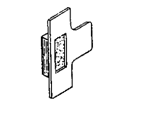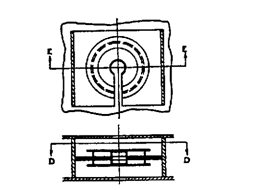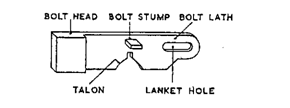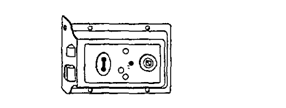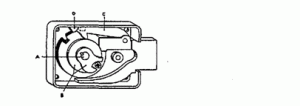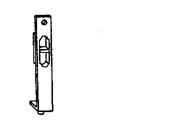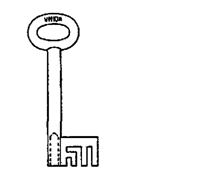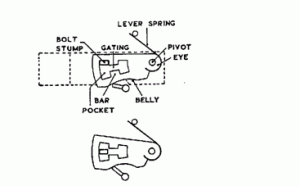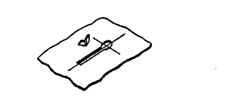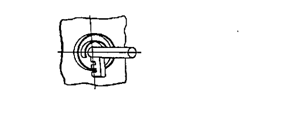Locksmith Terminology
If you want to learn about the different parts of a key and how they work, or what exactly is broken about your lock, our list of locksmith terminology can help clarify some of the more technical terms.
The following Glossary of Locksmith Terminology is provided courtesy of the Master Locksmith Association (MLA). Click on a letter below to be taken to its corresponding terms.
The following Glossary of Locksmith Terminology is provided courtesy of the Master Locksmith Association (MLA). Click on a letter below to be taken to its corresponding terms.
Glossary – A
Action – The arrangements of live or latch bolts and their accessories in a lock or latch, and how they function.
Alike change – More than one lock or latch which can be operated by the same key.
All to pass – Often referred to as “locks to pass” i.e. a numb of locks which can be passed or keyed alike (opened by the same key).
Angle cuts – A measurement usually expressed in degrees, for the angle between the two sides of a key cut.
Anti-thrust bolt – A spring bolt, for a night latch particularly, which cannot be pushed back when it has shot out and fastened a door, although it can be withdrawn by knob or key. This security device is usually achieved by a dog inside the latch case which falls behind the bolt and keeps it shot out when an auxiliary slide is pushed in.
Anti-thrust plate – An overlapping metal plate fitted to outward opening doors so as to prevent access to lock bolts.
Armoured forend – The American term for a double forend, comprising one inner and one separate outer forend.
Automatic deadlatch – A deadlatch, the main bolt of which is automatically locked (or deadlocked) when the door is closed.
Glossary – B
Backplate -The plate, fixed on a door, to which the moving parts of a lock or latch are attached.
Backset – The horizontal distance from the outside face of the outer forend to the centre of the keyhole or follower hole (or both). Designated as the “keyhole backset” or “follower backset”.
Banbury Lock or wooden stock lock – An old style door lock in which the various metal pieces are fitted separately in a block of wood which, in effect, forms the lock case.
Bar (of Lever) – The part between the pockets which is slotted to allow the bolt stump to pass through.
Barrel – See “Plug”.
Barrel and Curtain – This is the full name of a security device fitted in some locks to turn and close the keyhole when the key or any other instrument inserted through the keyhole is turned. The barrel is a tubular part surrounding that portion of the shank of the key which enters the lock, and the curtain, attached to the barrel, is a disc fitting close to the underside of the cap of the lock. A spring with its end to enter the notch in the edge of the curtain is usually fitted to keep the barrel and curtain in place.
Barrel Bolt – The common kind of door bolt having a round shoot running in a long continuous guide or strap attached to the backplate, the shoot being provided with a knob or the equivalent for operation by hand.
Barrel Key – An American term for pipe key.
Bathroom lock – A lock with a springbolt operable on both sides by furniture, and a deadbolt operable from the inside only, usually by thumb turn.
Belly (of Lever) – The edge, generally curved, which the key touches.
Birmingham Bar – A steel bar fitted to the inside face of a door frame on the hinge side.
Bit (of key) or key bit – That part of a key which is specially shaped or notched to operate the mechanism of its own particular lock or latch.
Bitting – The shaping or notching of a key blank to transform it into a key to operate its own lock or latch. Blade (of key) That part of a cylinder or lever key that is to be or has been notched.
Blank (key) or key blank – A partly made key, which has been shaped to enter the keyhole of a certain type of lock or latch, but of which the blade has not been finally notched to operate any individual lock.
Bolt – The part of a lock or latch which provides the fastening or engagement by protruding from the case or forend to engage in the staple, striking plate, link, shackle or other member.
Bolt head – The portion of a bolt that protrudes beyond the case or forend of a lock.
Bolt hole – The hole in a case, forend, plate or staple to guide and/or admit the bolt.
Bolt Stump – According to some authorities, this is the name of the part that upstands, usually rectangular in section, on a dead bolt or runner which passes through the slot or gating in the levers as the bolt moves.
Bow (of key) – That part of the key which is held in the fingers when operating the lock or latch.
Box Lock – A lock for fitting to the front of a box with a hinged lid. In the larger sizes the bolt of the lock, usually key operated, has two locking points to engage the two links on the linkplate which is fixed to the lid.
Box Striker or box striking plate – A striking plate having a box shape around the bolt hole to receive the deadbolt, used for greater security.
Bridge Ward – The kind fitted in some two side locks, the wards being fixed to a plate or bridge which is in the centre of the thickness of the lock and carried on cheeks.
BSS British Standard Specification – Authorised and issued by the British Standards Institute, the accepted UK authority for all standards of performance, tests and manufacture.
BS 3621:200:2004 – British Standard specification for Thief Resistant Locks for hinged doors. Locks submitted for certification must satisfy the requirements of the ten stringent clauses of the specification
Bullet or Bulleted – 1. In a key, bullets are the longitudinal grooves or projections or both on a key bit requiring a keyhole formed to suit,
2. In a lock, they are the corresponding grooves or projections or both at the keyhole, designed to prevent the entry of a key which is not properly shaped.
Burglar Bars – Steel bars, usually round or square in profile, frames. cut to length and fixed internally to window
Bush – A lining (usually brass) around the key – or follower – hole in a lock case, giving smoother working and longer life to the rotating parts. The keyhole bush is often milled so as to form wards on one or both sides of the inside of the lock case. See “Sashwards”.
Glossary – C
Cabinet lock – A generic term to include all locks of any type for use on pieces of furniture, such as cupboards, drawers, chests, boxes and the like.
Cam – Usually a tongue fixed to the end of the plug of a cylinder lock or latch.
Cam lock – A complete locking assembly in the form of a cylinder whose cam is the actual locking bolt.
Cap (of the lock) – The removable cover to a lock mechanism.
Case – That part of a lock or latch containing the mechanism.
Casement Door – A hinged door or pair of doors almost wholly glazed; often called a French Window.
Casement Window – A window in which one or’rhore lights are hinged to open.
Centres – The vertical measurement in an upright or sash lock between the centre of the keyhole and the centre of the follower hole.
Chamber – The holes in cylinder housings that house top pins (drivers) and springs.
Change Key – The key which opens one particular lock, the term is usually used with Master-Keyed Suites. (Servant key).
Change (of key) – See “Differ”.
Change Key Locks – These are locks which can be operated by any key chosen from a large number of different keys that have been made for the purpose. The selected key is the only one which will open the lock until a change is deliberately made.
Changing Key – One used in some keyless combination and change key locks to enable the combination to be altered.
Circlip – A ring with open ends which can be sprung into place on a plug or other part to permit rotation but to prevent endways movement.
Claw bolt – A type of deadbolt having pivoted claws which swing out sideways when the bolt is shot. Such locks are usually fixed to sliding doors.
Clutch headed screw – Threaded screws suitable for wood or metal with a shaped head allowing clockwise action to fix but no anticlockwise action to remove.
Close shackle padlock – A padlock, the body of which is built up so that the minimum amount of shackle is visible when locked. It offers improved security against forcing or use of bolt-croppers.
Coined – A term which signifies embossing, that is, the forcing of cold metal between dies to give it form without cutting the metal. The impressions on coins at the Royal Mint are made in this way – hence the name – and so are those on the bows of cylinder keys.
Collar – The shoulder on the shank of a rim, mortice or bitted key, controlling the point at which the key comes to rest after being fully inserted into the lock. The collar is the datum point from which the key is measured.
Collar – Ward A side ward cut closest to the pin adjacent to the collar.
Combination Lock – An abbreviation of name for a keyless combination lock.
Concealed fixing (of locks or latches) – A strong backplate is screwed to the door, the lock case slides over it and is secured in position by two or more grub screws which are concealed whenever the door is closed. This is usually associated with security nightlatches.
Connecting bar – The thin metal strip fitted to the rear of the plug which transmits the motion from the tumbler mechanism of the cylinder to the springbolt in the case of a cylinder rim latch or lock. It passes through the thickness of the door, and is usually indented at intervals to facilitate shortening to the correct length.
Connecting screws – The two screws which fix the cylinder body to the backplate.
Cover – The part of a lock or latch which covers the mechanism and is fixed, usually by screwing, to the case.
Cross differ – An error situation whereby change keys (servant keys) operate more than one lock when this was not intended.
Cross rail – The horizontal member of a door.
Cross suiting – This is a departure from straightforward master keying and is best explained by examples of cases which often occur:
1. Two or more different servant keys are required to pass one lock, all being in the same suite or subsuite.
2. One servant key is required to pass two or more different locks, all being in the same suite or subsuite.
3. A servant or submaster key of one subsuite is required to pass one or more locks in another subsuite.
Cut cabinet lock – A cupboard or drawer lock, the flange of which is recessed into the edge of the drawer or door.
Curtain – An abbreviation for barrel and curtain.
Cylinder – Usually the cylinder with inner co-axial plug which houses the pins, top pins (drivers), or disc tumblers and springs in the cylinder body.
Cylinder housing – With all component parts removed, this forms the main body or housing of a cylinder.
Cylinder key – A key, having a bow and long blade in which Vee cuts are made along the upper edge to operate the pins and drivers in a pin tumbler mechanism.
Cylinder lock or latch – Any lock or latch, the mechanism of which is contained in a cylinder.
Cylinder rose – (or ring) A shaped metal disc which surrounds the outer face of the cylinder of a cylinder mechanism assembly. ft usually stands slightly proud of the outside face of door.
Glossary – D
Deadbolt – The square-ended bolt of a lock which is moved in both the locking and unlocking directions by the key (but occasionally by thumb turn inside only) to provide fastening.
N.B. For obvious reasons, it is inadvisable to incorporate the thumb turn with the deadbolt of any deadlock or lock which is supposed to offer good security, if used on glass or wood panelled doors.
Deadlatch – A nightlatch or latch, the springbolt of which can be locked (or deadlocked) by key or other means.
Deadlock – A lock having only a square-ended deadbolt operable from one or both sides by key, and occasionally from outside only by key, inside by thumb turn. Sometimes operable only from outside and with no inside keyhole, which is designated a single-entry deadlock.
Detainer – 1. A generic term, not widely used, for any part such as a lever or tumbler which keeps a lock bolt in position
2. The name of the sliding security members in Butter’s System locks.
Differs – An abbreviation of “different combinations” or changes.
Disc tumblers – The small shaped discs (usually of metal) in the disc tumbler mechanism which are the means of providing different combinations.
Disc tumbler lock – A cylinder lock having disc instead of pin tumblers.
Divided Follower – Another name for a split follower, to allow independent operation form either side of a lock case.
Door Closer – A device for closing a door or gate automatically after opening. There are numerous types available.
Door viewer – Optical device fitted through a door to enable observation without opening the door.
Double Bitted Key – One with a bit on each side, of the shank.
Double Feather Spring – Two separate feather springs, fitting closely together one inside the other. Alternatively both may be made from one length of material and remain joined at one end. A spring so made is more lively and likely to last longer than a single spring of thicker material.
Double-handed lock – 1. A lock designed for use either as a right or left hand installation without alteration, generally by turning upside down. The keyhole has a circular formation at each end of the slot to accept the shank of the key.
2. A cupboard lock, the bolt of which can be shot either way to protrude from either side of the case.
Double locking – 1. By introducing a different cam arrangement into the action of a cylinder rim nightlatch it is possible to give a double or deadlocking facility at no extra cost. A simple opposite turn of the key in the outside cylinder deadlocks both bolt and inside knob simultaneously. This gives protection against the bolt-forcing and the glass or wood panel breaking intruder.
2. Also where a lever lock shoots its bolt by more than one turn of the key, thus doubling the distance of its shoot.
Drilled-through spindle (for lock furniture) – Usually shortened to DY A spindle with a few holes drilled at each end, one of which accepts the screw passing through the neck of the knob (or lever handle) in the door furniture.
Drillpin (sometimes pin) – A fixed stump or pin in a lock onto which the hollow shank of a pipe key fits when inserted to operate the lock.
Drivers (Top pins) – Pins that rest outside the plug of a cylinder when the key has created the shear line and are housed in the chambers of the cylinder housing. Drivers can be of various shapes other than cylindrical, so as to form anti-rap pins or anti-pick pins. See “Mushroom Drivers”.
Drop – 1. In drawer, chest, box or similar cabinet locks, the vertical distance from the outside face of the top edge or selvage to the centre of the keyhole.
2. Sometimes this term is used for a keyhole cover on a padlock.
Drop Arm – The member C in the illustration below, by which the bolt of the keyless combination lock is operated when the combination is set up.
Dust cap (or cover) – A keyhole cover on a padlock and some car-door locks to prevent dust from entering the keyway. It is actually an escutcheon.
Glossary – E
Ear of Key or shoulder – The projecting stop on one or both edges of a pin tumbler or other key near the bow to prevent the key from being pushed too far into the lock.
Ear of Key or shoulder – The projecting stop on one or both edges of a pin tumbler or other key near the bow to prevent the key from being pushed too far into the lock.
Glossary – F
Face plate – The outer of a double forend. A strip of metal fixed to the inner forend, thus forming a double forend.
False Notches or false gating – 1. The notches in the bar of the levers and the bolt stump of some locks to improve the security against attempted picking.
2. Cuts or notches which are put in some keys to give the appearance of greater intricacy although they serve no useful purpose
Feather Spring – A spring made of flat strip bent approximately to a V shape with a loop or eye at the apex of the V to fit over a stump of the Lockcase.
Final exit door – The exit door through which entry must later be obtained, and so cannot be bolted. It is usually the front entrance door or final means of exiting.
Flat steel key – A key made from steel sheet or strip, without corrugations in the thickness, but having the edge(s) notched to provide the differs.
Flush Bolt – A door bolt which can be recessed flush into the edge or face of a door.
Follower – That part of the latchbolt or (to which furniture is attached) which or horns which act on the bolt foot. springbolt mechanism containing a square hole to admit the spindle withdraws the springbolt when turned. It has one or two projections.
Forend – That part of the lock or latch through which the bolt(s) protrude, and by which the lock or latch is fixed to the door.
Four-way lock – A rim lock so made that it can be fitted as either a right hand or left hand installation on doors opening either inwards or outwards, without alteration, except that in some types the springbolt may need reversing.
Full rebated (lock or forend) – A mortice lock or latch with a specially shaped forend and striking plate to suit the shaped meeting edge of a single door which overlaps the door frame or a pair of doors which overlap each other – and such overlap or rebate is at the centre of the door thickness. Such locks or latches are always handed, and the hand must be stated when ordering together with the size of the rebate. See “Handing”.
Full width padbar – Usually purpose made, a steel bar spanning the full width opening of a door with supporting brackets or staples fixed to the frame and secured by a padlock.
Furniture – The additional items needed, which are screwed to one or both sides of the door to enable a lock or latch to be manually operated. Known as door furniture, lock or latch furniture, locksets or latchsets (when complete with lock or latch) and can be either knob, lever handle, pull handle or push button.
Glossary – G
Gating – The slot in a lever through which the bolt stump passes or goes into during the travel of the bolt or runner.
Grand Master Key – When a series of locks is divided into two or more sub-suites the key which controls all the sub-suites (i.e. all the locks in the entire complex) is called the grand master key.
Great Grand Master Key – One higher in degree than a grand master key. It is used only in very special arrangements of master keyed locks.
Guards – A guard is a fixed part inside a lock to prevent false keys from turning, or to prevent an instrument ‘from reaching the bolt or levers. Some guards are plates suitably shaped which the manufacturer can arrange variously in a number of locks to provide the differs.
Gunmetal – Another term for bronze. NB. To avoid confusion between Polished Brass (PB), Polished Bronze is symbolised by PG (Polished Gunmetal).
Glossary – H
Handing of doors, windows, cupboards, and other openings
Hasp and staple – A fastening in two pieces for a door or box to be secured by a padlock. The hinged part is called the hasp which is fitted to the door or lid of a box and shuts over the staple, which is on the door frame (or other leaf of a pair of doors) or the body of the box. For real security it is essential to use a hasp and staple with concealed fixing, i.e. the heads of the fixing screws are completely covered when the padlock is locked in position, as otherwise the fitment can easily be removed by withdrawing the screws affording nil security.
High Lift Lever – There are two kinds known by this name. One like A is truly a high lift lever because it must be lifted as high as possible to allow the bolt to move. The other kind as B has to be lifted high but not to the full extent. It can be overlifted and then the portion of bar below the gating prevents movement of the bolt. This form of lever is sometimes called a high middle lift lever which serves as a distinctive if not very exact term.
Hinge Bolts Fixed – steel protrusions fitted into the rear edge or hinge side of doors, closing into holes cut into the door frame, to protect from forced attack on the hinge side of the door.
Hold backstop – A thumb slide on the case of a cylinder rim nightlatch or in the forend of a cylinder mortice lock used either to hold back or alternatively deadlock the main bolt.
Hook bolt – A pivoted springbolt, the head of which is shaped in the form of a hook. Such locks or latches are usually fixed on sliding doors.
Hook Ward Key – The ward is fixed in the lock case formed as part of a circle like a wheel ward, but with a return or flange so that a cut in the key to fit would be L shape.
Horizontal lock – A mortice or rim lock having the follower hole further from the forend than the keyhole, but in the same horizontal plane. Used when knob furniture is specified to prevent the barking of knuckles on the door frame.
Glossary – I
Interpassing – An alternative name for cross suiting. Imitation BMA An electro deposited powder or lacquer finish on metal to simulate as nearly as possible the genuine Bronze Metal Antique finish. It is known as IBMA.
Glossary – J
Jamb – The vertical member of a door or window frame. In some areas the top rail of a door frame is referred to as the top jamb.
Glossary – K
Keep or Keeper – A term sometimes used, particularly in the North, for a staple or striking plate.
Key – A small removable device for operating the mechanism of its own lock, locking latch or nightlatch.
Key-bitting machine or key cutting machine – A machine for cutting keys from key blanks.
Key blank – A partly-made key, which has been shaped to enter the keyhole of a certain type of lock or latch, but of which the blade has not been finally shaped (i.e. notched or bitted) to operate the mechanism of the lock.
Key change – A term sometimes used instead of “differ”. The change or differ of the key is generally indicated by numbers and sometimes numbers and letters marked on the bow.
Keyhole – The hole into which the key enters to operate the lock or latch. It is often referred to as the keyway, particularly in a cylinder mechanism.
Key Steps or key depths – This term usually means the bolt step and lever steps of a key for a lever lock.
Glossary – L
Latch – The type of product with one bolt only, the bevelled springbolt or roller bolt, to latch or fasten the door, but not capable of being locked. Certain types, e.g. locking latches, nightlatches, or deadlatches, can, however, be locked by key or other means.
Latchbolt – See “Springbolt”.
Latchset – A latch complete with necessary furniture including a spindle, ready for fixing to the door.
Latchset furniture or latch furniture – A latchset, minus the latch.
Lever – A fiat shaped movable detainer in a lock, usually for the purpose of providing security and differs. The lever(s) in a lock have to be actually moved by the key to operate the lock. The belly of the lever is cut away to various depths to provide different combinations.
Lever mechanism – A lock mechanism having, as its principle feature, one or more levers.
Lever and warded mechanism – The lever mechanism with the addition of wards, usually for providing a greater number of differs. The addition of wards does not, however, increase the security of a lock. See “Wards”.
Lever handle – A piece of lock or latch furniture, usually on a rose or plate, for use as an alternative to a knob for operating the springbolt of a lock or latch. All British lever handles are spring-loaded to ensure the return to horizontal after use, but Continental lever handles are not usually spring-loaded and thus when used with British locks or latches, sometimes tend to sag below the horizontal after a comparatively short period of use, unless additional springing is included in the lock action.
Lever Pivot – The stump in a lock on which the levers swing.
Link Plate – The complementary member of box, desk and other locks which is fixed to the lid or some part of a cabinet, for example, and has one or more projecting links to enter the lock and engage the bolt.
Lip (of striking plate) – The projection on one side of a striking plate on the surface of which the springbolt of the lock or latch first strikes when the door is closed. It is usually radiused or bevelled to guide the springbolt.
Live bolt – See “Springbolt”.
Lock – A device operated usually, but not always, by a key, having one or more bolts or other members to fasten and secure a door, lid, drawer or other member.
Lockable bolt – A bolt that can be shot and locked in position by the use of a removable key.
Locking latch – A latch with a bevelled springbolt or roller bolt which is capable of being locked or secured, usually by key.
Lockset – A lock complete with necessary furniture including a spindle, ready for fixing to the door.
Lockset furniture or lock furniture – A lockset, minus the lock.
London strip – A steel bar fitted to the inside face of a door frame, shaped to accommodate the staple or striker of a rim latch lock.
Long shackle (LS) – A padlock shackle with a greater amount of clearance than the normal standard shackle.
Lubrication – On no account should oil be used to lubricate pin-tumbler cylinders. Graphite is the conventional lubricant for this mechanism.
Glossary – M
Master Key – A key which will open every lock in a master keyed suite.
Master Keyed (locks or latches) – A lock or latch capable-of being operated also by a master key as well as its own change or servant key.
Master Pins – Small pins sometimes called wafers to build up chamber pin loading in pin tumbler master keyed cylinders.
Mechanism (of locks or latches) – The arrangement of the component parts and the manner in which they perform to achieve the required security and differing when operated by its key. Main mechanisms include: (i) pin-tumbler, (ii) lever, (iii) discs, (iv) wards. There are other specialised mechanisms, e.g. Butters or Bramah.
Mortice – A hole cut into the thickness of one edge of a door to receive a mortice lock or latch.
Mortice lock (or latch) – A lock or latch which is morticed or let into the thickness of the door from the meeting edge and held in position by screws through the forend.
Mushroom driver – A driver in the cylinder mechanism which is tapered and has a mushroom shaped head. These provide a very effective anti-pick element, as they cannot be lifted by a lock-pick or similar item. When manipulated, the mushroom drivers tilt and wedge the plug at the line of intersection. For example, all Yale cylinder rim, cylinder mortice locks and cylinder padlocks have mushroom drivers incorporated in the mechanism.
Glossary – N
Narrow case lock or latch – A rim lock or latch, the case of which is made specially narrow, usually less than three inches wide, for fixing to the narrow stile of a panelled or flush door.
Nib Ward – The simplest form of ward made by pressing inwards a portion of the metal of the case or cap of the lock. A key to suit only requires a plain slot in the bit.
Nightlatch – A rim or mortice latch with a bevelled springbolt or roller bolt which shoots when the door is closed, but can be withdrawn by key from outside and by knob or lever handle from inside. Usually provided with a stop knob, slide or snib to hold the bolt retracted and to deadlock the bolt when shot in the closed position, even against the action of the key.
Nozzle – A circular boss or ferrule containing the keyhole on some cabinet locks, including locker locks. Correctly relating to lever cabinet locks.
Glossary – O
One-sided lock (single-entry) – A lock which has a keyhole on one side only, so that it can be operated by key from one side only, usually outside, but not from both. Nearly all cabinet locks and all padlocks are examples. Some high quality cylinder mortice locks are one-sided.
One-way action – An action where the follower will turn only one way.
Glossary – P
Padlock – A comparatively small removable and portable locking device, usually but not always key operated on one side only. The locking member is a circular hinged sliding or swivelled shackle which passes through a hole in a staple, locking bar or similar member.
Pan – The removable mechanism chamber attached to the inside face of a safe door.
Panel grilles – Steel grilles made to size with various infills of expanded diamond mesh, square weldmesh or fancy infills, usually fitted internally.
Passing (or to pass) – Any key which operates a lock is said to pass the lock. If locks are made “alike change” one key will pass all the locks.
Peg Ward – A combination of wards resembling a sash ward but fixed by pegs to the lock case.
Pin key – A key with solid shank (usually but not always circular) and a projecting blade at one end and a bow at the other.
Pin tumbler mechanism – The mechanism incorporated in the cylinder or body of a cylinder pin tumbler lock, latch or padlock, usually referred to as a cylinder lock, latch or padlock. Other than padlocks, the cylinder with its co-axial plug housing the pins and drivers under spring pressure passes through the thickness of the door, and the correct key lines up the pins and drivers to make a clear line of intersection between plug and cylinder, thus allowing the plug to rotate and the lock to be operated. The mechanism offers high security against key interchangeability and anti-pick mushroom drivers are usually included in every cylinder. For example, Yale 5 pin cylinders offer up to 24,000 differs as standard. It is also very suitable for master keying, as many different types of locks or latches can be included in the suite. Under master key, 12,200 differs are obtainable and under grand master key, 36 different sub suites with up to a total of 2,200 differs can be provided.
Pins – Usually the lower of each pair of tumblers in the pin tumbler cylinder mechanism. The upper are known as drivers.
Pipe key – A key with a flat bit and a hollow circular shank to locate on the drillpin. Used only on one-sided locks.
Plug – The part of the pin-tumbler cylinder mechanism or disc tumbler cylinder mechanism into which the key enters and which the key turns. It houses the pins of a pin tumbler cylinder mechanism or the discs and springs of a disc tumbler cylinder mechanism.
Pocket – The name of each segmental space in a lever which, while surrounding the bolt stump, allows the lever to rise and fall whether the lock bolt is in or out.
Postal handle – A letter plate with a pull handle.
Postal knocker – A letter plate with a pull handle, the latter specially adapted and used as a knocker.
Glossary – R
Rack Bolt – A bolt, usually a door bolt, which is toothed so that it may be operated by a pinion.
Radiused forend – A lock forend which is shaped radially, for use on one of a pair of swing doors.
Retaining Ring – 1. Usually a ring made of spring material which can be sprung open or closed for getting into position in order to retain some part or parts. 2. a circlip.
Rounded forend – A forend with rounded ends. It is used when the mortice for a forend is cut out by router, usually by machined manufacture of wood or metal doors.
Rebate – The measurement of the stepped reduction or recess in the forend of a rebated lock.
Rebated (lock or latch) – A mortice lock or latch with a forend specially shaped to correspond with the shaped meeting edge of the door for which it is intended. See “Full Rebated”.
Release – A striker in various forms to replace the lock strike and is operated electronically.
Relocker – A locking mechanism independent of any key operations, mounted remotely within a safe mechanism so as to relock the boltwork under certain forced attacks.
Repeat differs – That supply of differs which have been issued previously. This is usually associated with master keyed suites and where a replacement lock is required to have the same differ as the original.
Reversed bolt (RB) – A springbolt which has been turned round in its case to suit a door opening outwards instead of inwards. Great care should be taken to use this term RB only when ordering items which are required with the springbolt reversed.
Rigid grilles – Heavy duty, welded construction, rod or bar grilles, usually fitted externally or internally to the fabric of a building.
Rim Cylinder – This relates to a pack which usually comprises the cylinder with plug, rose, ‘connecting bar, two connecting screws and two keys.
Rim lock or latch – A lock or latch that is fitted by screwing on to the inside face of the door.
Roller bolt – A springbolt made in the form of a roller, instead of being bevelled. It is recommended for more silent and easier closing of a door. It does not need reversing to alter the hand.
Rose – 1. A cylinder rose or ring in cylinder locks or latches. It is a shaped metal disc which surrounds the outer face of the cylinder
2. In door furniture, it is the small plate to which the lever handle or knob is affixed and which is screwed to the door surface.
Glossary – S
Safe Lock – A general term for the many varieties of key operated and other locks for safes.
Sash lock – An upright mortice lock, consisting of a latch bolt and a key operated bolt.
Sash ward – Used in rim and mortice locks, alone or in conjunction with levers for the purpose of obtaining or increasing the differs. Formed pieces of concentric metal are affixed around the inside of the keyhole. It also serves as a keyhole bush. The bitted key passes over these wards to operate the bolt. Little security is given when sash wards are used by themselves. See “Skeleton Keys”.
Scotch spring lock – A two-bolt rim lock with the reversible springbolt above or below the horizontal plane of the follower. The scotch spring tapers and its thicker end is fastened to the lock case, the thinner end bears on a pivoted arm fixed to the end of the bolt. There is usually a cut-out in the cover to reveal the end of the spring.
Servant key – The change key of one (or more than one if of the same change) lock in a master keyed or grand master keyed suite.
Set Screw – One which tightens or fastens another part after assembly or adjustment.
Shackle – The hinged, sliding or swivelling loop shaped member of a padlock. The heel of the shackle remains always in the padlock body and the toe of the shackle comes out when unlocked. A double locking padlock gives the greatest security against forcing because there are two separate bolts locking outwards in opposite directions, one into a niche in the heel of the shackle, and the other into the toe of the shackle. This is sometimes called heel and toe locking.
Shank (of key) – The part of a pin or pipe key between the bow and the end, excluding the blade.
Shear Line – The term is used to denote the line of the circumference of the plug in the bore of a pin tumbler cylinder.
Shoot – 1. The outward movement of a lock bolt and the distance which it travels under the action of a spring or key. Shoot applies more particularly to spring bolts, throw being a better word for dead bolts.
2. The sliding part of a door bolt.
Shoot (of bolt) – The distance a springbolt moves under the action of its spring.
Shoulder (or bow stop) – The projection or ear or shape that controls the point at which a cylinder or disk tumbler comes to rest when fully inserted into the lock. It is the datum point from which spacing cuts are measured.
Side Bar – This is in addition to the existing pin or disc mechanism, and is a bar usually along the length mechanism and does not allow rotation until the mechanism is correctly lifted and can be directly controlled by the key.
Side Wards – Notches cut into the sides of bitted keys so fashioned to enable the key to turn.
Skeleton key – A key, the blade of which has been cut away sufficiently to allow the blade to pass any wards or obstructions within the lock and throw or retract the bolt. There is no universal skeleton key. One has to be prepared for each series of warded locks. Skeleton keys cannot be made for lever and cylinder lock mechanisms.
Sliding grilles – Steel sliding grille gates in single or double leaf, running on top and bottom guide tracks, locked by padlock or integral lock.
Sliding Lever – A lever which slides between or on guides instead of swinging on a pivot.
Spindle – That part of the door furniture usually of square section which passes through the follower hole and is fitted to the knob(s) or lever handle(s) to operate the springbolt.
Spoon – The flattened end of a padlock shackle containing the bolt hole or slot which the bolt enters.
Spacer – A distance piece of thin metal placed between the levers of some locks.
Spacing – The term used to describe the horizontal distances across a key blade or bit.
Spiral – Spring 1. A spring made of wire to approximately V shape like a feather spring; with one or more coils formed at the apex of the V to fit over a stump in the lock case. 2. A coil spring
Spring-loaded – Moved under the control of, or against the pull of, a spring fixed at one end.
Spring shackle padlock – A padlock, the shackle of which springs open when unlocked, and is locked by snapping to.
Springbolt – Sometimes called the latchbolt. A bolt having the outer edge shaped by bevelling of the vertical face. It is a bolt which may be pushed back into the lock-case and will return to the extended position without mechanical assistance.
Springlatch – A latch with one bevelled springbolt that locks the door when shut. It is opened by key from the outside and by knob from inside.
Staple – 1 A box-like fitting on the jamb of an inward opening door, and into which the bolt or bolts of a rim latch or lock shoot when door is closed. (It is sometimes referred to in Scotland and the North of England as a Bosshead). Some staples are lipped to act as a guide for the springbolt.
2. Part of a hasp and staple for use with a padlock. The padlock shackle passes through the eye or hole in the staple.
Steel lining – Steel sheet linings applied to external or both faces of a door; usually screwed and bolted through.
Stile – A vertical member of a door.
Stop knob (snib) – A device incorporated in some latches and locking latches to hold the bolt retracted or deadlock the bolt when door is closed.
Stop button(s -) There are generally two in number. They are incorporated in the forend of certain cylinder mortice nightlatches or locks. One button, when depressed, renders the outside furniture inoperable and the other, when depressed, restores the power of operation. They are useful for privacy and on vestibule doors. They are sometimes referred to as “stopworks”.
Straight cabinet lock – A cabinet lock, with no flange on the case, for flush fitting to cupboards and drawers.
Striking plate – Sometimes referred to as a “striker”. It is a shaped flat metal plate fixed to the door frame or jamb with one or more bolt holes into which the bolt or bolts shoot. There is a shaped projecting lip on one side to guide the springbolt. It is used with all mortice locks or latches, and with rim locks or latches with reversed springbolt on an outward opening door.
Sub Grand Master Key – A key which will operate all locks in its own main group or (sub-grand suite) of a grand master keyed system.
Sub Master Key – A key which will operate all locks in its own smaller group (or sub-suite) of a grand master keyed system.
Suite (of locks) – A group or collection of locks and/or locking latches and padlocks of different types and changes incorporated together under a master key or grand master key.
Glossary – T
Talon – The gap that is formed by two curves to the radius of the bolt step of the key in a deadbolt lathe or runner of a lever lock where the key engages the bolt.
Throating – The space between the collar and the nearer edge of the bit of two side keys.
Throw – The distance a deadbolt moves under the action of its key.
Thumb turn – A small fitting, on the inside of a mortice lock, which is gripped between thumb and finger to operate the deadbolt. It should not be used on glass- or wood-panelled doors.
Till lock – A drawer lock, or more correctly a cabinet lock, having a springbolt that shoots upwards and a vertical keyhole. It is self-closing and is unlocked by key.
Tie bars – The horizontal members of a vertical bar grille.
Time Lock – A clockwork or electric timing device which disallows operation of a lock or the opening of a door on safes or strongrooms.
Toe – The extreme tip of a bitted key.
Tubular mortice lock or latch – A lock or latch so designed that the case is tubular in form. The fitting of this type of latch requires only the drilling of a round hole into the edge of the door into which the lock or latch is fitted, and secured in position by screws in the forend. It is very economical in fitting time.
Tumbler – A movable detainer which must be lifted before the bolt of a lock can move.
Glossary – U
Upright lock – A mortice or rim lock upright in form, of which the case is narrow and the centres of the follower hole and keyhole are in the same vertical plane. It is known also as a sashlock.
Glossary – V
Vee Cuts (of key) – The tumbler cuts in pin tumbler, disc tumbler and similar keys.
Glossary – W
Wafer Tumblers – An American name for flat sliding tumblers.
Wards – Fixed obstructions inside a lock case to preclude the use of wrong key, as the key is cut to pass over the wards and operate the lock. They are sometimes used in lever locks to give increased differs. Wards alone give very little security. See “Skeleton Key”.
Warded lock – Any lock or padlock, the mechanism of which makes use only of wards. Not recommended, due to lack of security.
Wheel Ward – This kind is often seen in cabinet locks. There may be one or more wards made of sheet metal of different heights bent into a curve. If fixed directly under the keyhole, the key cannot enter fully unless notched to suit. If the wards are fixed at the side of the keyhole, the key may be able to enter but cannot turn unless the cuts in the bit correspond with the wards. A large number of differences can be provided with this type of ward.

24/7 Service

Accredited locksmiths

Nationwide Service





